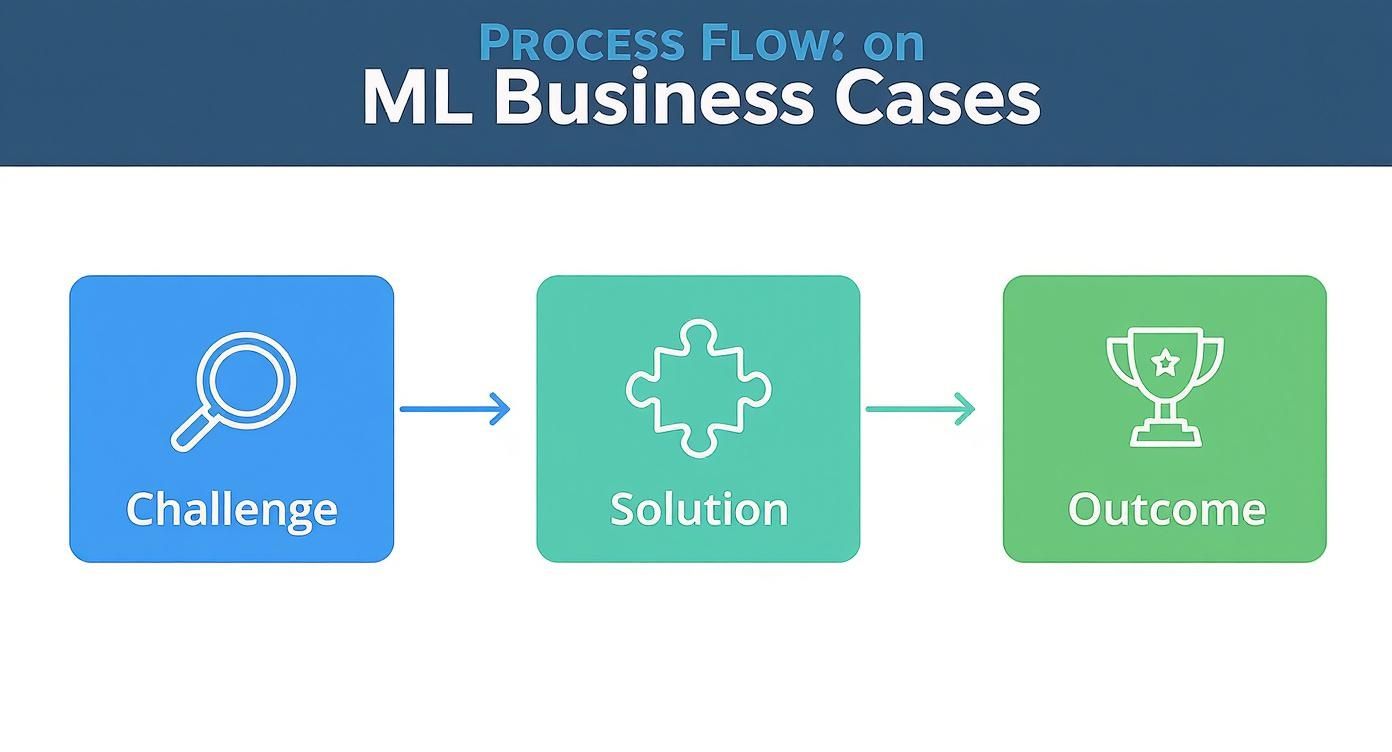Let's cut through the buzzwords. At its heart, using machine learning in your business is about teaching your computers to learn from your own data. This isn't about creating sentient robots; it's about making your systems smart enough to automate tasks, predict what's coming next, and ultimately, help you make much better decisions.
Imagine hiring a new employee who can sift through decades of sales figures in seconds to spot a trend you would have completely missed. That's the essence of it. You're moving away from guesswork and gut feelings toward a strategy that's firmly backed by your own data.
What Is Machine Learning and Why Should You Care?

Let's strip away the technical jargon for a moment. Machine learning is simply a branch of artificial intelligence (AI) that lets computers learn without needing a human to explicitly program every single step. Think of it like teaching a child by showing them examples, not by writing a long list of rules.
Instead of a developer writing a rule like, "If a customer buys product A, then recommend product B," you give the system a massive amount of your historical sales data. The machine learning model then works out the patterns on its own, discovering that customers who buy A also tend to buy C, D, and sometimes even F—connections a human might never spot.
This ability to self-learn is what makes it so powerful for modern businesses. You're essentially giving your systems the power to get smarter and adapt as they encounter new information.
From Manual Work to Smart Automation
So many business processes have traditionally relied on human intuition or fixed rules. An experienced salesperson just gets a feeling when a client might be about to leave, or a marketing manager has a hunch about which ad will connect with an audience. Machine learning takes that intuition and formalizes it by digging through the data to find the statistical proof behind those hunches.
"Your job will not be taken by AI. It will be taken by a person who knows how to use AI."
– Christina Inge, Marketing Expert & Harvard Instructor
This shift allows companies to go beyond simple automation, like sending out canned email replies, and into the realm of intelligent automation where the system itself makes nuanced decisions. For any business looking to scale and stay competitive, this is a critical leap.
The Real Business Benefits
So, why does this matter to your bottom line? The adoption of machine learning is exploding because it delivers real, tangible results. It helps you understand your customers and your own operations on a much deeper level than ever before.
Here are a few of the key advantages in plain English:
- Smarter Decision-Making: Imagine a tool that analyzes market trends, competitor pricing, and even the weather to suggest the perfect price for your products, every single day. That's machine learning helping you make confident strategic moves.
- Enhanced Customer Experience: It makes personalization possible at a massive scale. Think about how your favorite streaming service seems to know exactly what you want to watch next. That's ML making customers feel understood.
- Improved Efficiency: By automating complex and repetitive tasks—like flagging fraudulent transactions or sorting thousands of customer support tickets—you free up your amazing team to focus on creative, high-value work that a machine can't do.
The growth is impossible to ignore. Today, 78% of organizations worldwide are using AI, which is overwhelmingly powered by machine learning, in at least one part of their business. The global machine learning market is on track to grow from $113.10 billion to an incredible $503.40 billion by 2030.
At the end of the day, bringing machine learning into your company is about building a more resilient, efficient, and intelligent organization. If you want to dig deeper into the core concepts, feel free to check out our detailed guide on what is machine learning.
Real-World Machine Learning in Action
It's one thing to talk about machine learning in theory, but where does the rubber really meet the road? Let's move beyond the usual suspects like Netflix recommendations and look at how businesses like yours are using ML to make a real financial impact every single day.
This is where the concepts we've covered stop being abstract ideas and start becoming powerful tools for solving real problems. Companies aren't just dabbling in machine learning anymore; they're deploying it to fix specific, expensive headaches and to spot opportunities that were impossible to see before.
From Predictive Maintenance to Dynamic Pricing
Imagine you're running a factory or even a small chain of coffee shops. If a critical espresso machine goes down during the morning rush, the entire operation grinds to a halt, and you're losing money by the minute. That’s a classic business headache that machine learning is perfectly suited to solve.
Instead of just reacting to breakdowns, a smart business uses predictive maintenance. ML models can analyze data from sensors on the equipment—tracking everything from temperature and pressure to the number of shots pulled. They learn the subtle patterns that signal an impending failure and can alert the manager to schedule a fix before the disaster happens. Suddenly, a costly emergency becomes a routine, low-cost repair.
Or, think about an e-commerce business. How do you set the perfect price? Too high, and you lose sales; too low, and you leave money on the table. A dynamic pricing model, powered by machine learning, can analyze competitor prices, customer demand, inventory levels, and even the time of day in real-time. It automatically adjusts prices to keep you competitive and profitable, minute by minute.
Securing Transactions and Personalizing Service
Fraud is another massive headache, especially in finance and retail. A machine learning system can sift through thousands of transactions every second, spotting patterns of fraud much faster and more accurately than any human could. It learns what "normal" spending looks like for each customer and instantly flags anything that seems out of place, like a credit card being used in two different countries at the same time.
These examples drive home a critical point: machine learning isn't about using technology for technology's sake. It’s about zeroing in on a specific operational pain point and applying data to build a smarter, more efficient solution.
"A common mistake is to think of machine learning as a magic wand. In reality, it's a powerful tool that works best when applied to a well-defined business problem with clear success metrics." – Andrew Ng, AI Pioneer and Educator
The value machine learning brings is no longer hypothetical. Companies are seeing real, measurable improvements in productivity, costs, and customer satisfaction. Support functions like customer service, for instance, contribute 38% of AI’s total business value. Meanwhile, core areas like operations, marketing, and sales are also seeing major benefits. In fact, generative AI—a specific type of machine learning—is projected to boost productivity in marketing and sales by over 40%. You can dig deeper into these trends by exploring more machine learning statistics.
To really bring this home, let's look at how these applications play out across a typical company.
Machine Learning Applications Across Business Departments
The table below breaks down a few common ML use cases and shows their direct impact on the bottom line.
| Department | ML Application Example | Business Benefit |
|---|---|---|
| Marketing | Customer Segmentation – Grouping customers based on purchasing behavior and engagement. | Hyper-targeted campaigns that increase conversion rates and reduce ad spend. |
| Sales | Lead Scoring – Predicting which leads are most likely to convert into paying customers. | Sales teams can prioritize their efforts on the most promising prospects, boosting efficiency. |
| Operations | Inventory Optimization – Forecasting demand for products to avoid overstocking or stockouts. | Reduced storage costs, minimized waste, and ensures products are available when customers want them. |
| Customer Support | Automated Ticket Routing – Analyzing the text of a support ticket to send it to the right agent. | Faster response times and higher customer satisfaction, as issues are resolved more quickly. |
As you can see, each of these examples draws a straight line from a machine learning application to a clear business win. By identifying a challenge, applying a data-driven solution, and measuring the results, companies are turning machine learning from a buzzword into a true competitive edge.
Your 5-Step Roadmap for Adopting Machine Learning
So, you're ready to move from talking about machine learning to actually doing it? Good. Getting started isn’t some dark art reserved for tech giants. It’s a structured process that, when you break it down, is surprisingly straightforward. Forget thinking of it as a complex engineering project and start seeing it as a strategic business initiative.
This five-step roadmap is built for business leaders, not data scientists. It's a clear game plan to take your first machine learning project from a simple idea to a measurable business win. Follow along to ask the right questions at each stage and steer clear of the most common pitfalls.
Step 1: Pinpoint a High-Value Business Problem
The single biggest mistake companies make is starting with the technology. A successful project always, always begins with a real, nagging business problem. Don't ask, "Where can we use ML?" Ask, "What's our biggest operational headache right now?"
Look for parts of your business that are repetitive, inefficient, or overly reliant on guesswork. Are your sales forecasts constantly off the mark? Are customer support agents drowning in the same simple questions over and over? Is your team still spending hours manually categorizing inventory? These are all perfect starting points.
"The most common pitfall is focusing on the technology instead of the business problem. Successful projects always start by identifying a specific business challenge—like 'reducing customer service tickets by 20%'—and then using machine learning as the tool to solve it." – An expert opinion from an AI Strategist.
Choosing a problem with a clear, measurable outcome is critical. A goal to "improve customer satisfaction" is too vague to be useful. But a project designed to "reduce customer churn by 5% in the next quarter"? Now that’s specific, measurable, and tied directly to the bottom line.
Step 2: Check Your Data Health
Once you've zeroed in on the problem, it's time to look at your data. Machine learning models are like new hires; they can only learn from the information you give them. If your data is a mess—incomplete, inaccurate, or irrelevant—your results will be a letdown.
You don't need petabytes of data to get started. What you do need is quality data that’s directly relevant to the problem you're trying to solve.
Get your team together and ask a few tough questions:
- Do we collect the right data? If you want to predict which customers might leave, you need historical data on their behavior right before they did.
- Is our data accessible? Is it trapped in different systems or a dozen spreadsheets that don't talk to each other?
- Is our data clean? How many missing fields, typos, or weird inconsistencies are lurking in there?
Be prepared for this part to take a while. Data preparation often eats up the most time in an ML project, sometimes as much as 80% of the total effort. Getting a handle on your data health early will save you a world of hurt later.
Step 3: Choose Your Path: Build vs. Buy
With a clear problem and a good sense of your data, you’ve hit a fork in the road. Do you build a custom solution from scratch or buy a pre-built tool? There's no one-size-fits-all answer here. It comes down to your resources, your timeline, and just how unique your problem is.
-
Buying an Off-the-Shelf Solution: This is usually the fastest and most cost-effective way to get going. A lot of software you already use—from your CRM to marketing automation tools—now come with powerful machine learning features baked right in. This is a great option for common problems like lead scoring or product recommendations.
-
Building a Custom Solution: If your business problem is truly unique or you're aiming to create a one-of-a-kind competitive advantage, then building a custom model might be the way to go. This route requires a bigger investment in talent (like data scientists) and infrastructure, but it gives you total control.
For most businesses just dipping their toes into ML, starting with a "buy" or hybrid approach is the smart play. You can prove the value quickly without a massive upfront investment.
Step 4: Roll Out Your Solution
Alright, it's time to bring your solution to life. Deployment isn't just about flipping a technical switch; it's about weaving the new tool or process into your team's day-to-day work. The key here is to start small.
Don't try to overhaul an entire company-wide process overnight. Launch a pilot program with a small, controlled group. For instance, if you've developed a model to predict your most valuable sales leads, have one or two salespeople test its recommendations alongside their own intuition for a few weeks.
This approach lets you:
- Gather honest, real-world feedback.
- Iron out any technical kinks.
- Score some early wins to build momentum and get buy-in from the rest of the organization.
Step 5: Measure and Improve
Finally, remember that the work is never truly done. A machine learning model isn't a "set it and forget it" appliance. Markets shift, customer behaviors change, and new data is always coming in. Your model has to keep up.
This simple framework gets to the heart of every ML opportunity: identify a real challenge, craft a focused solution, and then obsessively measure the outcome.

This continuous loop is what makes machine learning so powerful for a business.
Establish clear Key Performance Indicators (KPIs) from day one. Did the lead scoring model actually boost the sales team's conversion rate? Did the predictive maintenance system cut machine downtime by the amount you targeted?
You have to continuously monitor your model’s performance against these business metrics. This ongoing cycle of measuring, learning, and refining is what turns a one-off science experiment into a genuine strategic asset that drives long-term growth.
Finding the Right Tools and Partners for Your Journey
Jumping into machine learning doesn’t mean you have to build an entire AI research lab from scratch. The market for tools and services has exploded, making it easier than ever for companies of all sizes to get started. The real trick is finding the right fit for your budget, your team's existing skills, and the specific problem you're trying to solve.
Think of it like building a house. You could source every piece of lumber and drive every nail yourself—that’s the custom, open-source approach. Or, you could hire a general contractor who manages everything with top-of-the-line equipment, like the major cloud platforms. You could even buy a high-quality prefabricated home that just needs assembling, which is a lot like using a specialized ML platform. Each path gets you a house, but the cost, effort, and final result are worlds apart.
Decoding Your Main Options
Navigating the machine learning landscape can feel overwhelming, but most solutions fall into one of three main buckets. Understanding them is the first step toward making a smart, strategic choice for your business.
-
Major Cloud Platforms (The "All-in-One" General Contractors): This is the world of giants like Amazon Web Services (AWS), Google AI Platform, and Microsoft Azure. They offer a massive suite of tools for everything from simple drag-and-drop model builders to complex infrastructure for custom development. They're incredibly scalable and powerful, but be prepared for a steep learning curve and potentially complex pricing.
-
Specialized Platforms (The "Plug-and-Play" Specialists): Companies like DataRobot or H2O.ai are laser-focused on making machine learning accessible, even for non-experts. Their platforms automate a huge chunk of the difficult data science work, allowing business analysts to build and deploy predictive models with minimal code. This path is often faster and easier, but you trade some of the customization you'd get from the big cloud providers.
-
Open-Source Tools (The "Build-it-Yourself" Approach): Here, you’re working directly with free, powerful libraries like TensorFlow or PyTorch. This route gives you maximum flexibility and total control, letting you build a completely custom solution. The catch? It requires significant in-house expertise—skilled data scientists and engineers—making it the most resource-intensive option by far.
Deciding between these paths is a critical strategic decision. This table breaks down the core trade-offs to help clarify your thinking.
Comparing Machine Learning Implementation Approaches
| Approach | Best For | Key Advantages | Potential Challenges |
|---|---|---|---|
| Cloud Platforms | Businesses that want powerful, scalable tools and may grow into more complex use cases. | Huge range of services, excellent scalability, strong community support. | Can be complex to navigate, potential for high costs if not managed carefully. |
| Specialized Platforms | Teams without dedicated data scientists who need to get results quickly. | Ease of use, speed to deployment, automates complex tasks. | Less flexibility, potential for vendor lock-in, can be expensive. |
| Open-Source | Companies with strong technical teams needing a highly customized solution. | Complete control and customization, no licensing fees, large developer communities. | Requires deep in-house expertise, longer development time, you manage everything. |
Choosing the right approach isn’t just about the technology; it's about aligning the tool with your business reality.
Making the Smart Choice for Your Business
So, how does a company make the right choice without breaking the bank? It really comes down to being realistic about your current capabilities and starting with a clear, manageable goal.
"A common mistake is to think you need a team of PhDs to start. The truth is, many businesses can get 80% of the value from 20% of the complexity by using an off-the-shelf tool for a well-defined problem." – AI Strategy Consultant
This is a fantastic piece of advice. Don't overcomplicate your first project. Its main purpose is to prove value, which leads you to a crucial decision about talent: do you build your team's skills, hire new people, or partner with an outside expert?
- Upskilling: Training your existing team is a great long-term investment. It builds internal knowledge and ensures that whatever you build is deeply connected to your business reality.
- Hiring: Bringing in an experienced data scientist or ML engineer can certainly accelerate your progress, but it’s a significant financial commitment.
- Consulting: For a first project, partnering with a consultant or agency can provide the perfect balance. You get expert guidance and a quick win, all while your own team learns the ropes.
Ultimately, the best path is the one that gets you a measurable result without derailing your business. You can explore our guide to the most common machine learning frameworks to see what tools power many of these solutions. By choosing wisely, you can turn machine learning into a genuine asset for growth.
Navigating the Hidden Risks and Ethical Questions
Embracing machine learning opens up a world of opportunity, but it’s not without its pitfalls. Once you move past the technical setup, you have to grapple with the non-technical side of ML—the hidden risks and ethical questions that can easily trip up even the most promising projects.
Getting this wrong can do more than just derail a project; it can seriously damage your brand's reputation and evaporate customer trust. This isn't about being scared of the technology. It's about being smart and proactive. When you start letting algorithms make decisions, you absolutely must understand the potential landmines, from data privacy scandals to biased outcomes that hurt real people.
The Problem of Algorithmic Bias
One of the biggest risks in machine learning is algorithmic bias. Here’s the simple truth: an ML model is only as good as the data it learns from. If your historical data reflects past biases—and almost all of it does—your model will not only learn those biases but can actually make them worse.
Think about a hiring tool trained on decades of company data where men held most of the senior roles. The algorithm could easily (and incorrectly) conclude that male candidates are a better fit for leadership, automatically sidelining qualified female applicants. The AI isn't being malicious; it’s just a mirror reflecting a flawed reality captured in the data.
"We have a very long way to go before we start correcting that bias. It is an absolute concern." – Christina Inge, Marketing Expert & Harvard Instructor
This kind of bias can show up anywhere. It could be in loan applications that unfairly deny people from certain neighborhoods or marketing campaigns that reinforce outdated stereotypes. The reputational fallout from a mistake like that can be huge and stick around for years.
Data Privacy and Security Imperatives
People are more concerned than ever about how their personal information is being used. Since machine learning models often need enormous amounts of data to work well, the responsibility to protect that data falls squarely on your shoulders.
A data breach isn't just a technical glitch; it's a profound violation of trust. Regulations like Europe's General Data Protection Regulation (GDPR) have put strict rules and massive fines in place for companies that fail to protect user data. These laws highlight a core principle: you are a custodian of your customers' information, and you have to treat it that way.
This is where a solid framework is non-negotiable. Your data handling has to be secure, compliant, and transparent. To build that strong foundation, understanding data governance best practices is an essential first step toward using ML responsibly.
Building Ethical Guardrails for Success
So, how do you push forward with innovation without stumbling into these ethical traps? The answer is to bake ethical thinking into your machine learning process from day one. It can't be an afterthought.
Here are a few practical steps to get started:
- Audit Your Data: Before you even think about training a model, actively hunt for and correct potential biases in your datasets.
- Demand Transparency: You need to know why your model is making certain decisions. "Black box" models, where the inner workings are a mystery, are a big risk for high-stakes applications.
- Keep Humans in the Loop: For critical decisions, think of ML as a co-pilot, not the autopilot. Make sure a human being has the final say.
Ultimately, successful and sustainable machine learning is about more than just brilliant code. It’s about building systems that are fair, secure, and worthy of your customers’ trust. By navigating these risks with your eyes open, you can make sure your journey into AI is both profitable and principled.
Measuring the True Impact of Your ML Projects

So, your first machine learning project is live. The technical team is thrilled with the model's high accuracy, but what does that actually mean for the business? If you want to prove the investment was worth it, you have to look past the engineering jargon and focus on metrics that matter to your bottom line.
The real success of machine learning isn't measured in algorithms; it's measured in dollars saved, revenue gained, and customers who stick around. You need a straightforward way to connect your project directly to a strategic business goal.
Tying ML to Business KPIs
The very first step is to define what success looks like in plain business terms. Before a project even kicks off, you should be able to finish this sentence: "We'll know this is a success if we see a measurable change in _______." This simple exercise links the technical work to a tangible Key Performance Indicator (KPI).
"A common mistake is to think of machine learning as a magic wand. In reality, it's a powerful tool that works best when applied to a well-defined business problem with clear success metrics." – Andrew Ng, AI Pioneer and Educator
Getting this clarity is everything. It shifts the conversation from abstract technical achievements to concrete financial and operational wins. It’s the difference between celebrating an algorithm and celebrating a 15% drop in customer churn.
Practical Examples of Success Metrics
Let’s make this real. For every machine learning application, there's a business KPI that proves its value. Instead of getting bogged down in the technical weeds, focus on tracking these kinds of outcomes:
- Predictive Maintenance Model: Don't just track prediction accuracy. Instead, measure the reduction in unscheduled downtime and the decrease in emergency repair costs.
- Sales Lead Scoring System: The key metric isn't the model's precision. It's the increase in the sales team's conversion rate and a shorter sales cycle.
- Automated Customer Support Bot: Go beyond counting how many tickets it handles. Focus on the reduction in human agent workload and the improvement in customer satisfaction (CSAT) scores.
Creating a Measurement Framework
To track your progress, you need a simple feedback loop. Always start by setting a baseline—find out what your chosen KPI looks like before the ML solution goes live. Once it’s deployed, keep a close eye on that same KPI.
This process breaks down into a few key steps:
- Define the Goal: Pinpoint the specific business metric you want to move.
- Establish a Baseline: Measure your current performance for 30-60 days before you roll anything out.
- Deploy and Track: Launch the ML solution and monitor the KPI in real-time.
- Analyze and Iterate: Compare the new results to your baseline. This is how you calculate ROI and spot opportunities to make the model even better.
Following this approach holds every machine learning initiative accountable to a clear business objective. It proves you’re delivering real, measurable value, which makes it much easier to justify future investments in your AI journey.
Got Questions About AI in Your Business? You're Not Alone.
Even with a solid plan, stepping into the world of machine learning can feel like venturing into the unknown. It’s natural to have questions about the budget, the team, and what it really takes to get off the ground. We’ve heard them all, so we’ve put together some straight-talk answers to the questions business leaders ask most.
This isn't a technical manual. Think of it as a quick conversation to clear up the confusion and help you move forward with confidence.
What’s the Real Cost of a Machine Learning Project?
This is the big one, isn't it? The honest answer is: it depends. The price tag can range from a few thousand dollars for a focused pilot project using an off-the-shelf tool to well into the millions for a custom-built system at the core of your operations.
No matter the scale, the major costs always come down to three things:
- Data Preparation: Getting your data clean, organized, and ready for use is often the most labor-intensive part of the job.
- Talent: The cost of data scientists, ML engineers, or specialized consultants.
- Computing Power: The cloud or on-premise infrastructure needed to train and run your models.
A piece of advice you'll hear from anyone who's been through this: start small. Run a tightly-scoped pilot project with a clear, measurable goal. Prove the value first, then you'll have the business case for a bigger investment.
Do I Need a Team of Data Scientists From Day One?
Not necessarily. The myth that you need a room full of PhDs to even start is what stops a lot of companies from ever beginning. Thankfully, that’s just not true anymore.
Many businesses get their first wins by using modern, user-friendly AI platforms. These tools empower people you already have—like sharp business analysts—to build effective models without writing code. Another smart move is to bring in a specialized consultant for your first project. They get you results fast and your team learns by doing, right alongside an expert.
How Much Data Do I Actually Need?
It's tempting to think you need mountains of data, but this is a classic quality-over-quantity situation. The right amount of data really depends on what you're trying to accomplish. A simple sales forecasting model might only need a few hundred records of past sales data, whereas a complex image recognition tool could require millions of examples.
The key isn’t having "big data"—it's having clean, relevant, and well-labeled data. Start with the business problem you want to solve. That will tell you exactly what kind of data you need to find the answer.
What's the Biggest Mistake Most Businesses Make with AI?
Without a doubt, it's focusing on the shiny new technology instead of the business problem. Too many leaders get swept up in the idea of "doing AI" without a specific, valuable goal in mind. They start with the solution—machine learning—and then go searching for a problem it might fix.
The successful projects always work the other way around. They start with a real-world pain point, like "we need to cut customer churn by 15% this year," and then identify machine learning as the right tool to get the job done.
Ready to turn these insights into action? At YourAI2Day, we provide the latest news, tools, and expert opinions to help you make smarter decisions on your AI journey. Explore our resources at https://www.yourai2day.com.





